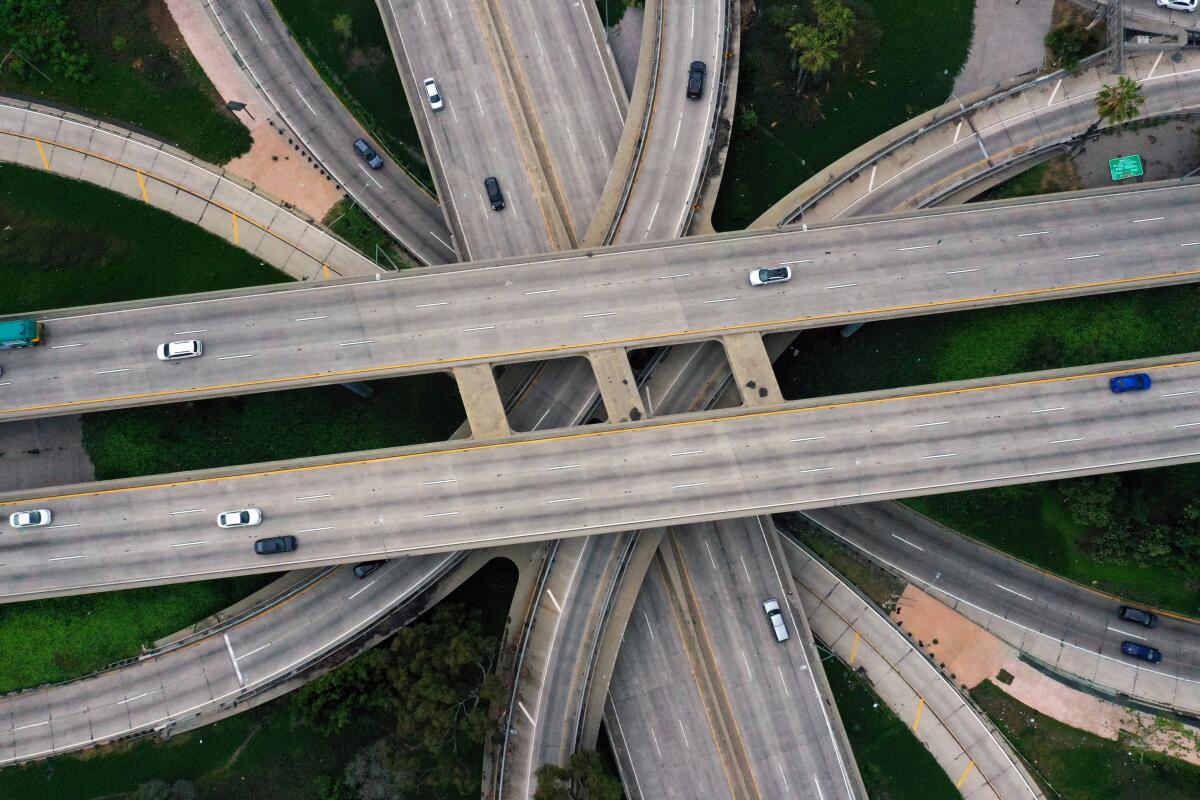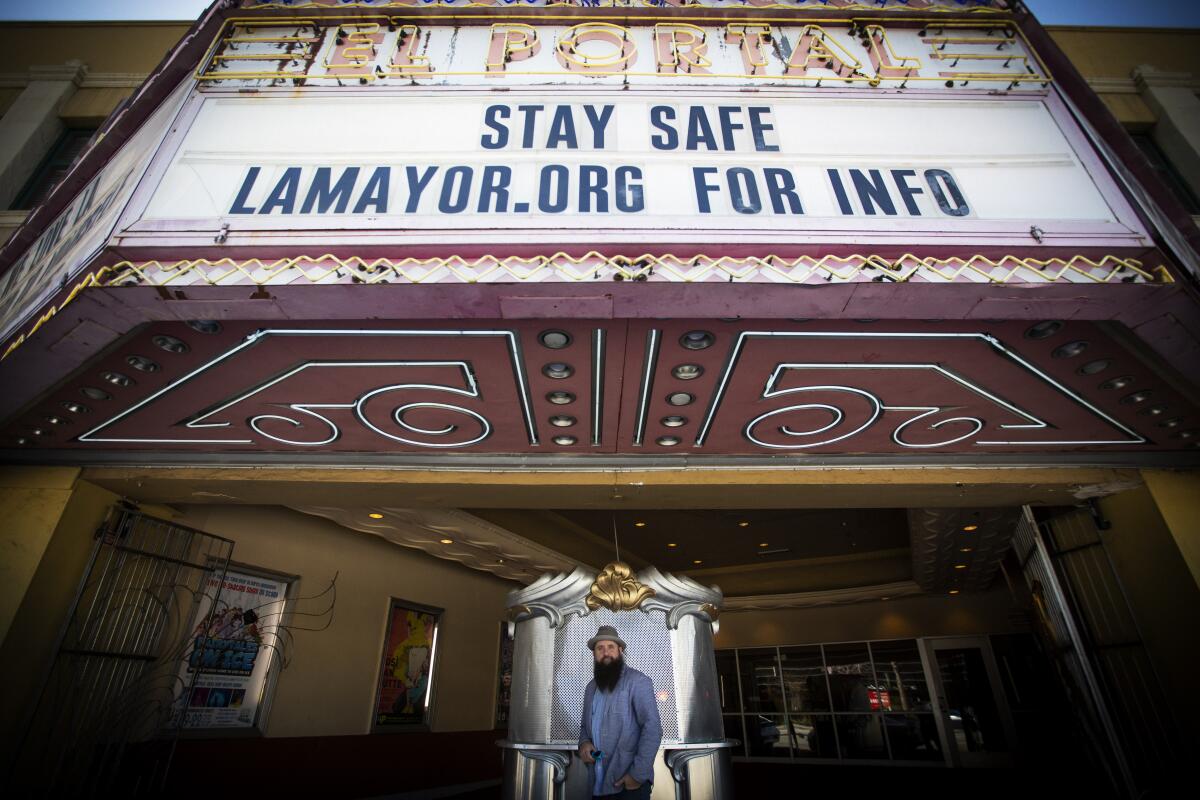Essential Arts: Coronavirus can’t stop L.A.’s most devoted museum fan
- Share via
My layers have grown out and I’m looking like Mandy Patinkin in “The Princess Bride.” I’m Carolina A. Miranda, staff writer at the Los Angeles Times, with the week’s essential arts news — and important playwright boxer shorts.
Essential image
Michael LeVell‘s solo show at Tierra del Sol Gallery in Chinatown was supposed to have a March 14 opening. Like countless other exhibitions, it was canceled. LeVell’s work is inspired by the pages of Architectural Digest. The artist, who is legally blind, holds the magazine close to study its lines and forms and creates works inspired by what he sees.
Make the most of L.A.
Get our guide to events and happenings in the SoCal arts scene. In your inbox every Monday and Friday morning.
You may occasionally receive promotional content from the Los Angeles Times.
Learn more about LeVell by visiting the gallery’s website, which features a video walk-through of the show. (His ceramics of furnishings, btw, are really charming.)
No. 1 fan
In an absolute beaut of a story, Times culture reporter Deborah Vankin hung with Ben Barcelona, a retiree whose pre-pandemic routine consisted of going to a different museum every day: MOCA on Mondays, the Broad on Tuesdays, the Hammer on Wednesdays and so on. He talked to Vankin about how he’s making do and offers some sage advice: “What’s happening today, it feels like wintertime. But there will be a spring. There will be fields and flowers.”

Art in the time of corona
Times art critic Christopher Knight digs into the nature of plagues and propaganda by having a look at a towering canvas of Napoleon by 18th century French painter Antoine-Jean Gros that hangs at the Louvre. The painting shows the French leader in Jaffa, touching a victim of the plague in a way that evokes “a secular Christ,” writes Knight. The image obfuscates what really happened: Napoleon ordered sick soldiers euthanized so they wouldn’t hold up his military campaign. Read to the end for a blazing kicker.
At a moment in which culture is delivered over airwaves and internet, classical music critic Mark Swed says it’s a good idea to consider the work of Glenn Gould, who with his “Solitude Trilogy” had a “seemingly astonishing prescience for our pandemic predicament.” The artist’s “gripping radio documentaries,” writes Swed, “make essential listening for an era of creative podcasts in which the medium offers new interest in how radio pioneered experiments with narrative.”
Bonus: This week Swed also has some excellent gear recommendations, including his preferred digital to analog converters (or DACs) for richer sound.
Enjoying this newsletter? Consider subscribing to the Los Angeles Times
Your support helps us deliver the news that matters most. Become a subscriber.
Theater critic Charles McNulty explores how Arthur Miller’s “Death of A Salesman” speaks to our economic moment, in which workers are being laid off by the millions. “The play,” he writes, “ reminds us of the unchanging truth of an American dream dangled for the many but obtainable only by a ruthless few.” (A good companion piece to this is this Times story about how the mega-rich are weathering the storm. Hint: Nordic skiing.)
The Times’ Jessica Gelt reports on a musician couple in Pasadena — cellist Beong-Soo Kim and pianist Bonnie Wongtrakool — who are giving free porch concerts. “I think it’s just our very tiny way of saying to our neighbors and any passersby, ‘We’re in this together,’” says Kim.

Julissa James reports on Olivia Arthur, a Highland Park artist who has turned the fence around her home into an impromptu gallery. Arthur describes the project as a “a drive-by gallery for neighbors.”
And since we’re in a feel-good groove, here are the kids of the Silverlake Conservatory singing David Bowie’s “Space Oddity.”
Design and the virus
Architecture contributor Sam Lubell looks at how past pandemics have shaped the design of cities and how COVID-19 may do the same — such as the creation of more flexible urban spaces that can adapt to shifting needs. Coronavirus, he writes, is “shaking loose notions of what is ‘normal’ in a field still employing many of the same techniques it did a century ago.”

Speaking of shifting design: Urbanism writer Linda Poon says maybe it’s time for developers and residential architects to rethink balconies, which have provided critical outdoor space to apartment dwellers during this time.
The city of Milan is beginning to look at how public spaces will be managed after it emerges from lockdown. Among the changes coming: 22 miles of road space reserved for cars will be turned over to cyclists and pedestrians instead.
Coronavirus and the arts
This week, I take an extensive look at how the pandemic has affected the gallery scene in L.A. This includes an informal survey of almost three dozen galleries and interviews with gallerists around the city. A quarter of the respondents, nine of 35, said they are facing the permanent closure of their spaces in 2020 if the situation doesn’t improve quickly. “No one is coming out of this unscathed,” says Eva Chimento, founder of Chimento Contemporary.
One bit of good news: galleries are coming together to see one another through the crisis: Deitch and a host of L.A. spaces are working on launching a shared sales platform called galleryplatform.la.
As part of that effort, reports Jori Finkel, they will form a long-term citywide art dealers association called Gallery Association Los Angeles (GALA).
Jessica Gelt looks at a survey by the new coalition of arts organizations, Artist Relief. The group is giving $5,000 grants to 100 artists per week. In the first 15 days, the organizers were flooded with 55,000 applications. About 11,000 artists responded to questions. One data point: 62% of respondents reported they are now unemployed.
The Broad museum laid off 130 visitor services and retail employees this week. In a statement, the museum said daily operations are bound to change, affecting “future staffing needs dramatically.”
Likewise, the Metropolitan Museum of Art laid off 80 employees, cut executive pay and estimates that its budget shortfall for the next fiscal year could hit $150 million. And the Phillips Collection in Washington, D.C., has cut management pay and is furloughing workers.
Makeda Easter looks at how COVID-19 has intersected with AB 5, the state labor law that regulated the employment of freelancers and contractors. The pandemic could highlight “the good intention of the legislation, trying to support workers with their protections and benefits,” says Julie Baker, executive director of Californians for the Arts. But it’s also been a challenge for small-scale nonprofits whose budgets have been vaporized by the pandemic.

Because I need to follow up that thread with some needed humor: cartoonist Walter Scott imagines a post-coronavirus art world.
A new Warhol bio
Need some nonpandemic reading? Stephen Metcalf reviews Blake Gopnik’s behemoth, 976-page biography of Andy Warhol, which looks at how the oddball kid known as “Raggedy Andy” became the slick scenester of the Factory. “Warhol lived one of the great lives of the 20th century,” writes Metcalf. “He now has a biography worthy of that life.”
Since we’re on the subject of books: critic Mark Harris reads Woody Allen’s autobiography so you don’t have to.
An important milestone
In 1970, Mario Solis, a student in the Barrio Logan neighborhood of San Diego helped organize a takeover of a patch of land under the intersection of the 5 Freeway and the Coronado Bridge. That land became Chicano Park. The Times’ Daniel Hernandez examines its legacy: “Chicano Park reminds us,” says artist Soni López-Chávez, “that if we gather together and we fight for something, it is possible for us to win.”

The best arts online
Matt Cooper has been rounding up all the daily quarantine must-watches, including Patrick Stewart in the 2010 modern-dress production of “Macbeth” (it’s really good) and Alfred Molina as painter Mark Rothko in the original 2009 London production of John Logan’s “Red.”
Find Cooper’s latest daily listings at Things to Do: Arts & Culture.
To add my two cents: I’ve been digging the California Historical Society’s blog. The writers take an image or document and dissect it — like this early 20th century image that shows an improvised hospital used to treat victims of bubonic plague or this photo of a San Francisco street by Minor White, which evokes the empty cities of our day. Informative and enjoyable.
I’ve also been entertaining myself by combing through the Museum of Fine Arts, Houston’s new digital archive devoted to Latino and Latin American Art. The digitization effort was led by the museum’s International Center for the Arts of the Americas and includes prints, artist books, show fliers, news clips, Latin American art magazines and much, much more. So many treasures to get lost in.
For the parents: artist-designed coloring sheets.
Passages
Poet Lewis MacAdams, an early crusader for the ecology of the Los Angeles River, has died at 75. “The L.A. River speaks to me,” MacAdams once said. “And she’s been a vigorous muse.”
“There would not be a movement to save or restore the L.A. River without him,” Joe Edmiston, of the Santa Monica Conservancy told KCET. “he was able to provide some romance, some poetry, some vision that you didn’t see.”

Shirley Knight, a Tony- and Emmy-winning actress of stage and screen, known for playing a woman seduced and abandoned by Paul Newman in “Sweet Bird of Youth,” has died at the age of 83. In a tribute to the actress, Charles McNulty writes: “Luminous is an overused word in theater criticism, but the word is aptly applied to Shirley Knight.”
Tina Girouard, an artist who was a fixture of the SoHo art scene of the ‘70s, and who recently had a key work on view in MOCA’s Pattern & Decoration show, has died at 73.
In the news
— Artist Geoff McFetridge examines pandemic life in L.A. in illustration.
— How a group of key Modern artists, living in isolation during World War II, offered each other creative inspiration.
— Michael Lobel on how art was shaped (or not) by the 1918 flu pandemic.
— A 13-minute film by architects Andrés Jaque and Ivan Munuera charts the impact of the coronavirus on bodies — human, urban and politic.
— Architecture critic Mark Lamster has a fascinating story about a 19th century utopian community of French socialists that once set up camp in ... Dallas.
— Coco Fusco writes about how collective action among artists and intellectuals in Cuba helped get detained artist and activist Luis Manuel Otero released.
— L.A.’s Mike Kelley Foundation has announced its 2020 grant recipients.
— T Magazine looks at the legacy of black-owned galleries, including groundbreaking L.A. spaces like Brockman Gallery and Gallery 32.
— Aperture has gathered Spotify playlists by seven prominent photographers, including Nan Goldin, Alec Soth, Jamel Shabazz and Elle Pérez.
— @ratemyskyperoom is the best design Twitter feed of the pandemic.
And last but not least ...
Nathan Lane talking about Eugene O’Neill’s choners with Stephen Colbert is must-see TV.
The biggest entertainment stories
Get our big stories about Hollywood, film, television, music, arts, culture and more right in your inbox as soon as they publish.
You may occasionally receive promotional content from the Los Angeles Times.




